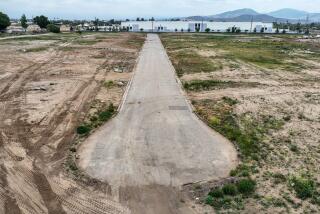Incinerator ‘Cleanses’ McColl Soil : EPA Says Test Burn Destroyed Dangerous Compounds
A controversial test run of a La Jolla experimental hazardous waste incinerator successfully destroyed potentially carcinogenic compounds in petroleum-contaminated soil from Fullerton’s McColl dump, according to preliminary results released this week by the U.S. Environmental Protection Agency.
Ogden Environmental Services’ incinerator successfully destroyed the compounds from the abandoned waste dump, exceeding the required 99.99% destruction of certain compounds during the 4-day test that began March 27.
“No significant levels of hazardous organic compounds left the system in the stack gas or remained in the bed and fly ash material,” according to an EPA report.
“We’re very happy with the preliminary results,” said Terry Wilson, spokesman for the EPA’s western regional office. “They met (requirements for) everything or exceeded them.”
The results, while still incomplete, are a significant step forward for the firm, which is attempting to win a lucrative federal Superfund contract to incinerate all 265,000 cubic yards of contaminated soil at the 8-acre waste dump in the foothills of western Fullerton.
Sparked 2-Year Battle
The company, whose plan to conduct the experiment in a populated section of La Jolla sparked a 2-year battle with environmentalists and the San Diego City Council, hopes to win permission to conduct a similar test burn in a mobile incinerator at the McColl site later this year. If successful, that test would allow Ogden to compete with other firms for the McColl cleanup contract.
Still to be determined by the EPA is whether the combustion process created highly carcinogenic dioxins, PCBs or furans.
“We’re delighted with it,” said Robert Wilbourn, Ogden’s director of operations and technical support. “We feel that it proves the technology. It doesn’t come as a surprise to us.”
Betty Porras, chairwoman of a citizens group that has been lobbying for the cleanup of McColl for the past 10 years, was equally pleased with the results.
“That gives the community a lot of hope that McColl can be cleaned up,” said Porras, chairwoman of the McColl Community Action Group.
Ogden and the city this week settled their 17-month legal battle over the test burn, when the city agreed to drop its appeal of a U.S. District Court judge’s order allowing the March test burn. In addition, the city agreed to pay Ogden $1.25 million in attorneys’ fees and damages for delaying the test burn.
The settlement is conditional on a federal court magistrate verifying that the emissions were not harmful to the public.
According to the EPA “fact sheet,” mailed this week to Ogden, Porras and others after the ongoing McColl cleanup, the experimental hazardous waste incinerator successfully destroyed a chemical tracer added to the 7,500 pounds of McColl waste and clean soil burned during the 31-hour test of the incinerator.
Exceeded Required Level
The incinerator, which reached temperatures as high as 1,700 degrees Fahrenheit, achieved a “destruction and removal efficiency” of 99.992%, exceeding the required 99.99% for the compound “carbon tetrachloride” inserted into the waste stream by evaluators.
The report showed that the incinerator dramatically reduced the quantities of benzene, toluene, naphthalene and four other compounds in stack gas emissions. In ash trapped in the incinerator’s bed and “baghouse” filter, the compounds were reduced to the point that they were undetectable.
By adding limestone to the waste mix as it was burned, the process more than neutralized the highly acidic waste, making it possible to bury the ash left behind.
Wilbourn said the incinerator also succeeded in limiting emissions of nitrogen oxides, carbon monoxide, hydrocarbons and hydrochloric acid.
A second EPA report is due in June, with a final evaluation due in August.
More to Read
Sign up for Essential California
The most important California stories and recommendations in your inbox every morning.
You may occasionally receive promotional content from the Los Angeles Times.










